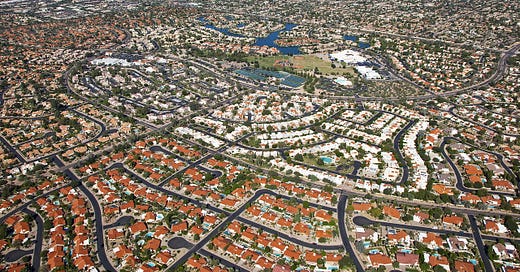The world's major cities continue to sprawl, with implications for climate change
New research suggests urban sprawl exacerbates climate change
Urban sprawl has been recognized as an environmental problem for decades. Building suburbs and shopping malls leads to longer drives to and from work, and to and from everywhere else, too. All those cars needed for those long drives pollute the atmosphere and spew planet-warming carbon dioxide. The individual, separate homes in suburbs use up more energy for heating and cooling than shared-wall dwellings such as condos or apartment buildings. Once folks buy a large suburban house, they have to fill each room with furniture; lawns need mowing; the property needs maintenance—all of which supercharges consumerism. Sprawl leads to social and political disengagement as well.
Sprawl transforms grasslands, farms, and forests into streets and buildings. According to the United Nations Framework Convention of Climate Change, the loss of green spaces contributes to climate change in more ways than one. Open green spaces have a greater albedo than the built environment: the sun’s rays don’t warm grass, shrubs, and trees as much as they do steel, concrete, and blacktop. The natural evapotranspiration of green plants also acts as a natural cooler. Green spaces may be as much as seven degrees cooler than adjacent urban areas.
Besides removing that cooling ability of the countryside, carbon sequestration is lost when grass, shrubs, and trees are converted to suburbia. Wood from trees cleared during development is rarely harvested. Trees are usually bulldozed or burned.
The loss of carbon sequestration from urban sprawl may not seem like a big deal, but it is. Emissions from land-use change has hovered around an annual rate of five billion tons of CO2 ever since the 1940s, making it the second largest source of carbon emissions after energy consumption.
The study
New research from China shows that most major cities have continued to sprawl. The researchers looked at the world’s 100 largest cities and how they grew over a ten-year period, from 2013 to 2022. Of the 100 cities, 83 had increased the size of their urban/suburban area. The researchers estimate that the subsequent loss of farmland and open spaces resulted in the release of 112 million tons of sequestered carbon.
The researchers used a combination of population density and urban area to choose the cities evaluated in the study. In some cases, cities that grew and merged together were considered to be a single large city. Thus, the largest “city” in the study is the urban megalopolis along the Pearl River in China comprising Guangzhou, Dongguan, Shenzhen, Foshan, and Zhuhai. Other groupings were the Chinese cities of Wuxi and Changzhou, as well as Hangzhou and Shaoxing. Similarly, Essen and Dortmund in Germany were grouped as a single city.

The researchers gathered their images and data from a U.S. land surveying satellite launched in 2013 and as well as high-quality GIS software. Images were selected from within two months of each other to reduce changes due to seasonal variation. Their results were published in the journal Sustainability in August of this year.
The research team extended the study areas 15 kilometers beyond the boundaries of each city to include the “leapfrogging” effect of sprawl; that is, the tendency of developers to skip over land adjacent to urban areas and build on cheaper land farther from cities. They also accounted for the differing carbon sequestration abilities of the encroached land. Forest and chaparral, for example, store carbon more effectively than deserts or some farmlands.
Most of the urban expansion occurred in China, India, and the U.S. The most sprawl was from the Pearl River megalopolis, which averaged 75 square miles of expansion annually, which would be as if they urbanized equivalent of the entire Washington D.C. area every year. Although cities in Europe and South America expanded, their rate of growth tended to be lower than the rest of the world.
I thought this study was well done, and it brings to light some important information. Nonetheless, it’s good to keep in mind that the study was limited to 100 cities and overlooked the sprawl happening in smaller bergs. From casual observation of my hometown in West Virginia, I’ve seen the physical footprint of the town expand even as the population declined. The published paper mantra “more research needs to be done” applies here. Perhaps a team can soon perform a more comprehensive study that includes more of the built world, including large cities and small towns.
The Chinese research team urged all cities to focus on preserving forests and other adjacent open areas and avoid rapid urban expansion. That is, of course, easier said than done. Despite its expense to those who live there, and despite the cultural and political isolation in which suburbanites find themselves, it seems we can’t stop ourselves from living in the burbs. Another recent study found that if current population trends continue, and we keep sprawling as we have traditionally done, urban lands will increase by more than 460,000 square miles by 2030. That is a tripling of the urban land cover since the year 2000 and an area larger than Texas, Oklahoma, and New Mexico combined.





Very interesting article, Paul. Clearly the way we do urban/suburban sprawl in the US and China is terrible for the planet. Do you have any sense of how these effects might be different for ultra dense but modern and green cities like Tokyo and Singapore that have ubiquitous mass transit, electric cars, and comparatively fewer people drive (especially gas)? These also harness solar effectively and often mix in green spaces and use design techniques to blunt the heat from buildings and pavement. I’m wondering if there is potential for well-designed urban planning to mitigate or have a net positive effect if done right
The even greater tragedy is that a good deal of sprawl in China was built on speculation and hardly anyone lives in these “ghost cities.” They paved paradise for nothing.